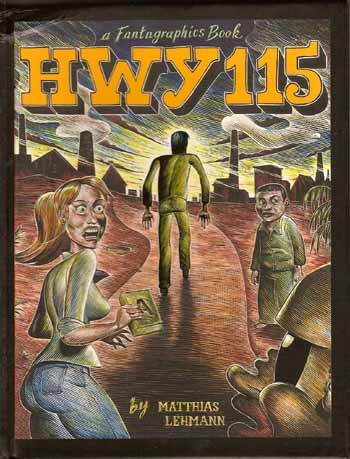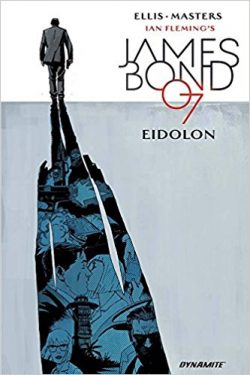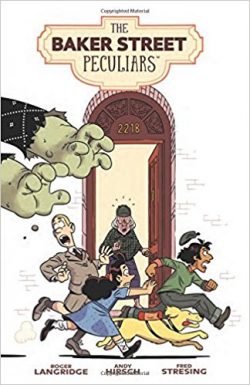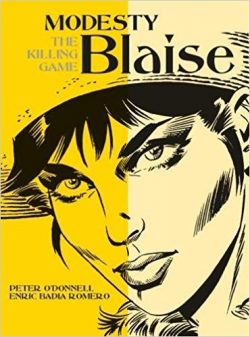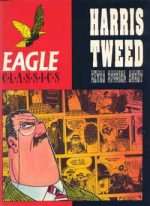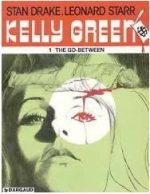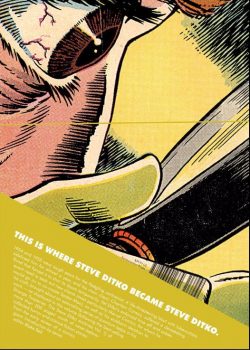
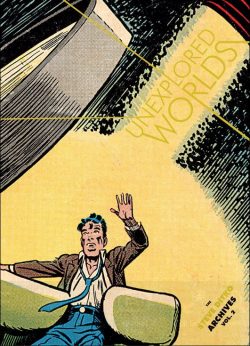
By Steve Ditko & various, edited by Blake Bell (Fantagraphics Books)
ISBN: 978-1-60699-289-0
Win’s Christmas Gift Recommendation: Immaculate Yule Yarn-Spinning… 9/10
Once upon a time the anthological title of short stand-alone stories was the sole staple of the comicbook profession, where the plan was to deliver as much variety as possible to the reader. Sadly, that particular vehicle of expression seems all but lost to us today…
Steve Ditko is one of our industry’s greatest talents and one of America’s least lauded. His fervent desire to just get on with his job and to tell stories the best way he can – whilst the noblest of aspirations – has always been a minor consideration or even stumbling block for the commercial interests which for so long controlled all comics production and still exert an overwhelming influence upon the mainstream bulk of comicbook output.
Before his time at Marvel, young Ditko perfected his craft creating short sharp yarns for a variety of companies and it’s an undeniable joy today to be able to look at this work from such an innocent time when he was just breaking into the industry: tirelessly honing his craft with genre tales for whichever publisher would have him, utterly free from the interference of intrusive editors.
This superb full-colour series of hardback collections (also available as digital editions) has reprinted those early efforts (all of them here are from 1956-1957) with material produced after the draconian, self-inflicted Comics Code Authority sanitised the industry following Senate Hearings and a public witch-hunt.
Most are wonderfully baroque and bizarre supernatural or science fantasy stories, but there are also examples of Westerns, Crime and Humour: cunningly presented in the order he completed and sold them rather than the more logical but far-less-revealing chronological release dates. Moreover, they are all helpfully annotated with a purchase number to indicate approximately when they were actually drawn – even the brace of tales done for Stan Lee’s pre-Marvel Atlas company.
Sadly, there’s no indication of how many (if any) were actually written by the moody master…
This second sublime selection reprints another heaping helping of his ever-more impressive works: most of it courtesy of the surprisingly liberal (at least in its trust of its employees’ creative instincts) sweat-shop publisher Charlton Comics.
And whilst we’re being technically accurate, it’s also important to reiterate that the cited publication dates of these stories have very little to do with when Ditko crafted them: as Charlton paid so little, the cheap, anthologically astute outfit had no problem in buying material it could leave on a shelf for months – if not years – until the right moment arrived to print. The work is assembled and runs here in the order Ditko submitted it, rather than when it reached the grubby sweaty paws of us readers…
Following an historically informative Introduction and passionate advocacy by Blake Bell, concentrating on Ditko’s near-death experience in 1954 (when the artist contracted tuberculosis) and subsequent absence and recovery, the evocatively eccentric excursions open with a monochrome meander into the realms of satire with the faux fable – we’d call it a mockumentary – ‘Starlight Starbright’ as first seen in From Here to Insanity (volume 3 #1 April 1956) before normal service resumes with financial fable ‘They’ll Be Some Changes Made’ (scripted by Carl Wessler from Atlas’ Journey Into Mystery #33, April 1956) wherein a petty-minded pauper builds a time machine to steal the fortune his ancestors squandered, whilst a crook seeking to exploit a mystic pool finds himself the victim of fate’s justice in ‘Those Who Vanish’ (Journey Into Mystery #38, September 1956 and again scripted by Wessler).
Almost – if not all – the Charlton material was scripted by the astoundingly fast and prolific Joe Gill at this time, and records are spotty at best so let’s assume his collaboration on all the material here beginning with ‘The Man Who Could Never Be Killed’ from Strange Suspense Stories #31, published in February 1957. This tale of a circus performer with an incredible ethereal secret segues into ‘Adrift in Space’ (Mysteries of Unexplored Worlds #8 June 1958) wherein a veteran starship captain pushes his weary crew over the edge whereas ‘The King of Planetoid X’ – from the previous MoUW (February) details a crisis of conscience for a benevolent and ultimately wise potentate…
The cover of Strange Suspense Stories #31 (February 1957) leads into ‘The Gloomy One’ as a misery-loving alien intruder is destroyed by simple human joy before the cover to Out of This World #5 September 1957 heralds that issue’s ‘The Man Who Stepped Out of a Cloud’ and an alien whose abduction plans only seem sinister in intent…
Mysteries of Unexplored Worlds #5 (October 1957) tells the story of a young ‘Stowaway’ who finds fulfilment aboard a harshly-run space ship after which the cover for Out of This World #3 (March 1957) leads to an apparent extraterrestrial paradise for weary star-men in ‘What Happened?’
Next up is a tale from one of Charlton’s earliest star characters. The title came from a radio show that Charlton licensed the rights to, with the lead/host/narrator acting more as voyeur than active participant. “The Mysterious Traveler†spoke directly to camera, asking readers for opinion and judgement as he shared a selection of funny, sad, scary and wondrous human-interest yarns, all tinged with a hint of the weird or supernatural. When rendered by Ditko, whose storytelling mastery, page design and full, lavish brushwork were just beginning to come into its mature full range, the contents of Tales of the Mysterious Traveler were always exotic and esoteric and utterly mesmerising…
From issue #2, February 1957, ‘What Wilbur Saw’ reveals the reward bestowed on a poverty-stricken country bumpkin who witnessed a modern-day miracle after which Out of This World #3 provides a cautionary tale of atomic mutation in ‘The Supermen’…
The eerie cover to Out of This World #4 (June 1957) leads to a chilling encounter for two stranded sailors who briefly board the ‘Flying Dutchman’ and Strange Suspense Stories #32’s cover (May 1957) dabbles in magic art when a collector is victimised by a thief who foolishly stumbles into ‘A World of His Own’. From the same issue comes a salutary parable concerning a rich practical joker who goes too far before succumbing to ‘The Last Laugh’, after which ‘Mystery Planet’ (Strange Suspense Stories #36, March 1958) offers a dash of interplanetary derring-do as a valiant agent Bryan Bodine and his comely associate Nedra confounds an intergalactic pirate piloting a planet-eating weapon against Earth!
A similarly bold defender then saves ‘The Conquered Earth’ from alien subjugation (Out of This World #4, June 1957) whilst in ‘Assignment Treason’ (Outer Space #18. August 1958) the clean-cut hero goes undercover to save earth from the predatory Master of Space whilst in Out of This World #8 (May 1958) ‘The Secret of Capt. X’ reveals that the inimical alien tyrant threatening humanity is not what he seems to be…
The cover to Mysteries of Unexplored Worlds #3 (April 1957) gives way to a trio of fantastic thrillers beginning with ‘The Strange Guests of Tsaurus’ as an alien paradise proves to be anything but and ‘A World Where I Was King’ sees a clumsy janitor catapulted into a wondrous realm where he wins a kingdom he doesn’t want. Diverting slightly, Fightin’ Army #20 (May 1957) provides a comedic interlude as a civil war soldier finds himself constantly indebted to ‘Gavin’s Stupid Mule’ before ‘A Forgotten World’ wraps up the MoUW #3 contributions with a scary tale of invasion from the Earth’s core…
‘The Cheapest Steak in Nome’ turns out to be defrosted from something that died millions of years ago in a light-hearted yarn from Mysteries of Unexplored Worlds #7 (February 1958) after which the cover to MoUW #4 (July 1957) precedes more icy antediluvian preservations found in the ‘Valley in the Mist’ whilst the cover to Strange Suspense Stories #33 (August 1957) leads into a bizarre corporate outreach project as the ‘Director of the Board’ attempts to go where no other exploitative capitalist has gone before…
It’s back to Mysteries of Unexplored Worlds #3 for a brush with the mythological in ‘They Didn’t Believe Him’ before ‘Forever and Ever’ (Strange Suspense Stories #33) reveals an unforeseen downside to immortality and Out of This World #3 sees a stranger share ‘My Secret’ with ordinary folk despite – or because – of a scurrilous blackmailer…
cover Mysteries of Unexplored Worlds #5 October 1957
‘A Dreamer’s World’ from Mysteries of Unexplored Worlds #5 (October 1957) follows the chilling cover thereof as a test pilot hits his aerial limit and discovers a whole new existence, before Unusual Tales #7 (May 1957) traces the tragic path of ‘The Man Who Could See Tomorrow’ whilst the cover of Tales of the Mysterious Traveler #4 (August 1957) opens a mini-feast of the voyeur’s voyages beginning with that issue’s ‘The Desert’ – a saga of polar privation and survival.
Tales of the Mysterious Traveler #3 (May 1957) offers the appropriate cover and a ‘Secret Mission’ for a spy parachuted into Prague after which TotMT #4 offers ‘Escape’ for an unemployed pilot dragged into a gun-running scam in a south American lost world; ‘Test of a Man’ sees a cruel animal trainer receive his just deserts and ‘Operation Blacksnake’ grittily reveals American venality in the ever-expanding Arabian oil trade…
Returning to Mysteries of Unexplored Worlds #5, ‘The Mirage’ torments an escaped convict who thinks he’s escaped his fate whilst Texas Rangers in Action #8 (July 1957) sees a ruthless rancher crushed by the weight of his own wicked actions in ‘The Only One’, after which the stunning covers to Unusual Tales #6 and 7 (February and May 1957) lead into our final vignette ‘The Man Who Painted on Air’: exposing and thwarting a unique talent to preserve humanity and make a few bucks on the side…
This sturdily capacious volume has episodes that terrify, amaze, amuse and enthral: utter delights of fantasy fiction with lean, plots and stripped-down dialogue that let the art set the tone, push the emotions and tell the tale, from times when a story could end sadly as well as happily and only wonderment was on the agenda, hidden or otherwise.
These stories display the sharp wit and contained comedic energy which made so many Spider-Man/J. Jonah Jameson confrontations an unforgettable treat half a decade later, and this is another cracking collection not only superb in its own right but as a telling tribute to the genius of one of the art-form’s greatest stylists.
This is something every serious comics fans would happily kill or die or be lost in time for…
Unexplored Worlds: The Steve Ditko Archive Vol. 2. This edition © 2010 Fantagraphics Books. Introduction © 2010 Blake Bell. All rights reserved.
